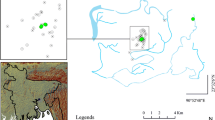Abstract
A study on arsenic (As) contamination in the groundwater of the Gaur Municipality, Rautahat district, Nepal was undertaken. We have designed a model, by backward stepwise regression analysis, to predict As concentration (R 2 = 67 %) when information on some covariates such as nitrate, bicarbonate, and total iron (Fe) is available. The model was applied to Nepal groundwater and verified for Bangladesh groundwater. This multivariate model may be used to predict As concentration in given anions and cations. The analysis of variance test showed that the model designed is statistically significant (p < 0.001). Among all the covariates, Fe content showed the strongest positive correlation with As. The multivariate model for predicting the As from the existing three explanatory variables (NO3, HCO3, and Fe) for Nepal groundwater is found as: \( {\hat{\text{A}}\text{s}} = 19.349 - 0.221\;{\text{NO}}_{3} - 0.041\; {\text{HCO}}_{3} + 3.274.50 \; {\text{Fe with }}R^{2} = 67\;\% , \) where As in μg/L, Nitrate bicarbonate, and Fe in mg/L. The release of As from the soil was found according to the Fe reduction hypothesis. The As concentration varied from 1 to 62 μg/L in the groundwater sample (n = 50) of both the private and public shallow tube-wells. Among analyzed sample units, one of the tube-well’s As concentration exceeded 50 μg/L, 18 were between 10 and 50 μg/L, and the rest (31) were below 10 μg/L.






Similar content being viewed by others
References
Anawar HM et al (2003) Geochemical occurrence of arsenic in groundwater of Bangladesh: sources and mobilization processes. J Geochem Explor 77(2–3):109–131
APHA, AWWA, WPCF (2000) Standard Methods for the examination of water and wastewater, the 20th edition
Berg M et al (2001) Arsenic contamination of groundwater and drinking waiter in Vietnam: a human health threat. Environ Sci Technol 35(13):2621–2626
Bhattacharya P et al (2003) Geogenic arsenic in groundwaters from Terai Alluvial Plain of Nepal. J Phys IV 107:173–176
Bhattacharyya R et al (2003) Groundwater As mobilization in the Bengal Delta Plain, the use of ferralite as a possible remedial measure—a case study. Appl Geochem 18(9):1435–1451
Chang J-S, Ren X, Kim K-W (2008) Biogeochemical cyclic activity of bacterial arsB in arsenic-contaminated mines. J Environ Sci 20(11):1348–1355
Dahal BM, Fuerhacker M, Mentler A, Shrestha RR, Blum WEH (2008) Screening of arsenic in irrigation water used for vegetable production in Nepal. Arch Agron Soil Sci 54(1):41–51
Deutsch WJ (1997) Groundwater geochemistry: fundamentals and applications to contamination. Lewis, Boca Raton
Ferguson JF, Gavis J (1972) Review of arsenic cycle in natural waters. Water Res 6(11):1259
Gulens J, Champ DR, Jackson RE (1973) Influence on redox environments on the mobility of arsenic in groundwater. Ann Arbor Science, Ann Arbor
Harvey CF et al (2002) Arsenic mobility and groundwater extraction in Bangladesh. Science 298(5598):1602–1606
Islam FS et al (2004) Role of metal-reducing bacteria in arsenic release from Bengal delta sediments. Nature 430(6995):68–71
Kanel SR, Choi H, Kim KW, Moon SH (2005a) Arsenic contamination in groundwater in Nepal: a new perspective and more health threat in South Asia. Natural Arsenic in Groundwater: Occurrence, Remediation and Management. Balkema, Leiden, pp 103–108
Kanel SR, Manning B, Charlet L, Choi H (2005b) Removal of arsenic(III) from groundwater by nanoscale zero-valent iron. Environ Sci Technol 39(5):1291–1298
Kanel SR, Greneche JM, Choi H (2006) Arsenic(V) removal kom groundwater using nano scale zero-valent iron as a colloidal reactive barrier material. Environ Sci Technol 40:2045–2050
Masscheleyn PH, Delaune RD, Patrick WH (1991) Arsenic and selenium chemistry as affected by sediment redox potential and pH. J Environ Qual 20(3):522–527
Mudhoo A, Sharma SK, Garg VK, Tseng CH (2011) Arsenic: an overview of applications, health, and environmental concerns and removal processes. Crit Rev Environ Sci Technol 41(5):435–519
Ngai TKK, Shrestha RR, Dangol B, Maharjan M, Murcott SE (2007) Design for sustainable development—household drinking water filter for arsenic and pathogen treatment in Nepal. J Environ Sci Health Part A Toxic/Hazard Subst Environ Eng 42(12):1879–1888
Nickson RT, McArthur JM, Ravenscroft P, Burgess WG, Ahmed KM (2000) Mechanism of arsenic release to groundwater, Bangladesh and West Bengal. Appl Geochem 15(4):403–413
Pierce ML, Moore CB (1982) Adsorption of arsenite and arsenate on amorphous iron hydroxide. Water Res 16(7):1247–1253
Pokhrel D, Bhandari BS, Viraraghavan T (2009) Arsenic contamination of groundwater in the Terai region of Nepal: an overview of health concerns and treatment options. Environ Int 35(1):157–161
Smedley PL, Kinniburgh DG (2002) A review of the source, behaviour and distribution of arsenic in natural waters. Appl Geochem 17(5):517–568
Smedley PL, Zhang M, Zhang G, Luo Z (2003) Mobilisation of arsenic and other trace elements in fluviolacustrine aquifers of the Huhhot Basin, Inner Mongolia. Appl Geochem 18(9):1453–1477
Stuben D, Berner Z, Chandrasekharam D, Karmakar J (2003) Arsenic enrichment in groundwater of West Bengal, India: geochemical evidence for mobilization of As under reducing conditions. Appl Geochem 18(9):1417–1434
Tandukar N (2001) Arsenic contamination in the groundwater in Rautahat District of Nepal: an assessment and treatment. Institute of Engineering, Tribhuvan University, Lalitpur
van Geen A et al (2008) Comparison of arsenic concentrations in simultaneously-collected groundwater and aquifer particles from Bangladesh, India, Vietnam, and Nepal. Appl Geochem 23(11):3244–3251
Welch AH, Lico MS (1998) Factors controlling As and U in shallow ground water, southern Carson Desert, Nevada. Appl Geochem 13(4):521–539
Acknowledgments
This research was supported by Ministry of Science and Technology through the International Environmental Research Center (UNU and GIST Joint Program) at Gwangju Institute of Science and Technology (GIST), Gwangju, The Republic of Korea. Authors would like to acknowledge Professor Mark N. Goltz, AFIT, for his critical and important comments and Ms Sheil Doran, Xavier University for her help in proofreading of the manuscript.
Author information
Authors and Affiliations
Corresponding author
Rights and permissions
About this article
Cite this article
Kanel, S.R., Malla, G.B. & Choi, H. Modeling and study of the mechanism of mobilization of arsenic contamination in the groundwater of Nepal in South Asia. Clean Techn Environ Policy 15, 1077–1082 (2013). https://doi.org/10.1007/s10098-013-0580-z
Received:
Accepted:
Published:
Issue Date:
DOI: https://doi.org/10.1007/s10098-013-0580-z




